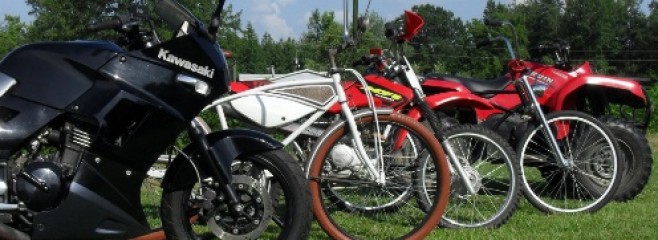It’s been a while since I updated this one, well because it’s been a while since I really had time to work on it. But spring is here and the days are getting longer and so much of the craziness of life is starting to settle down a little bit. While at the last swapmeet, I traded a guy some parts for an old aftermarket seat and brought it home. I tore the seat apart and removed all of mounting hardware, cover and the foam from the pan. After putting it into place and taking a few measurements I cut about 3 inches from the nose of it and narrowed the front end slightly.
After this I fired up the heat gun and reshaped the pan to fit the frame and the fender better. Then I borrowed the electric carving knife from the kitchen and trimmed the foam down to match.
The mounting points had to be relocated. The front tab that hooks to the frame just behind the gas tank was moved and bent to work in it’s new location. This seat originally had 2 angle brackets with captive screws on either side for its original application and those just were not going to work here. Instead I flattened one of them out and attached it to the rear of the seat as shown in this next picture.
Once everything was located & marked I brazed a square nut to the underside of the fender for the captive screw on the seat.
Now it’s time to move on to the battery box. You may find it a bit ironic that my day job is working as a CAD designer, mainly using Solidworks, and yet here I revert to my all time favorite C.A.D. system, good old fashioned cardboard aided design!
Some times you just gotta roll in old school style! First you cut out the pattern & tape it together.
Then you stick it into place on your motorcycle, and trim it and tweak it as necessary necessary to get it to fit.
The big advantage to building a cardboard prototype is that it is so fast, easy, & cheap to work with, allowing you to make quick corrections or try multiple ideas at no cost, with very little frustration. And if you screw up your piece of cardboard you can just go to the trash bin and get another one. Once you get the pattern correct you the cut all the tape, lay it out flat on the material of your choice, and mark around it for cutting and bending.
Here I am getting ready to transfer the pattern to some 1/8″ thick ABS plastic sheet. You can use sheet metal if you have the ability to bend it, or perhaps leave the pattern taped together and overmold it with fiberglass. I like the ABS because it is easy to thermo-form, the glue for it is ABS pipe glue available at any hardware store, and it is damn near indestructible. Next time I post on this you can see how the ABS gets folded and glued to make a battery box.
Peace Y’all









